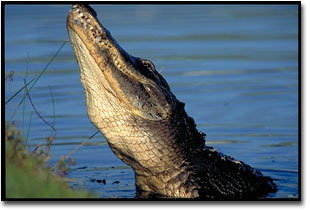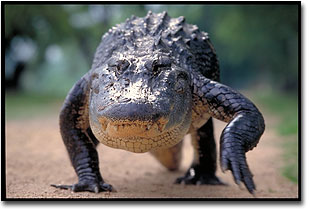|
|
 The Alligators of South Texas
Text and photography Copyright Philippe Henry The stereotype of Texas as a country of cowboys, long-horned cattle and the Wild West is so strong that most Europeans are unaware that there is a healthy alligator population over there. Even United States residents are often surprised to find out that the southeastern portion of Texas near the Gulf of Mexico has lakes, bayous, and coastal marshes that provide habitat for these reptiles and other swamp dwellers.
I remember once I was in a swamp, in the southern part of a ranch. The last patch of mist dispersed under a light breeze which brought to my ears a mysterious song. The soft sound of brushing grasses mingled with grunts and growls which seemed to be coming from the deep of the black waters. This was a song one can hear only today in the southeastern United States swamps, from the Carolinas to Texas the song of the American alligator. As the sun rose, the bellowing resonant choruses occured more often. The repeated call of adults alligators carried over great distance. As I got closer to a rookery where hundreds of cattle egret were nesting, I saw a bellowing beast. A big male alligator noticeably inflated as he arched his tail and head out of the water. Slowly waving his tail back and forth, he puffed out his throat, and with mouth closed, began to bellow by vibrating the air. Through the lens, I saw hundreds of fine water droplets dancing over its back as he began to vibrate the air inside his throat. It seemed motionless but I know that underwater, its whole torso vibrated, projecting infrasound notes, too low for the human to hear but which travel long distances and can be heard by other alligators.The sparkling droplets leaping all around the back of the calling male is a unique phenomenon called the alligator “water dance”. Very soon, this was like the rumbling of thunder coming from all parts of the swamp. Tens of alligators bellowed together. Alligators are long-lived, social animals that are territorial. They have bellows that are distinct enough so that other alligators are believed to be able to recognize the caller without seeing him or her. This may function not only in breeding activities, but also in setting up and keeping territories, warning juveniles and subadults to stay out of a territory, and facilitating the dispersion of alligators more evenly throughout a particular habitat. During the months I spent there, just to observe alligators, I have learned that they also communicate using body gestures to give a variety of information. I had close encounters with the same individuals, day after day. During spring and summer I saw that the dominant males, not only bellowed, but hissed, grunted, growled and roared, on land or in the water, but also acted in what I call, a beaver-like display. They slapped the surface of the water with their head and tail, sometimes several times in rapid succession. It often occured when another alligator came too close and it could be interpreted as a dominance display. During the two years I worked in South Texas, I had a few opportunities to photograph predation. Once I was in my blind, set up close to a “gator hole”, I quickly realised that alligators gobble up a few of these guests. It was the day an unlucky raccoon came for a drink at the alligator hole. I had been resting inside the blind when I was awakened by tens of noisy great blue herons and wood storks taking off.. By the time I got my camera ready, the raccoon was hanging from the jaws of the alligator, quite dead. I had just enough time for a few shots before the alligator vanished in the water with its prey. It is more common for an alligator to prey on mammals such as raccoons when these animals swim out to feed on birds and eggs at bird rookeries. In this manner they benefit the bird populations even though they occasionally eat a bird or two themselves.
The status of the alligator in Texas was reclassified from Endangered to Threatened by the U.S. Fish and Wildlife Service on November 14,1983. This change opened the doors to hunting and alligator farming. Alligators do not adhere to boundaries of parks and wildlife management areas and can present a nuisance as well. Urban sprawl has increased the likelihood of alligators showing up where they are unwelcome guests. A typical housing development may have a lake or detention pond that serves to attract alligators. Subadult alligators are especially prone to migrate to such areas to escape predation from larger alligators. Habitat destruction and alteration may displace adult alligators and encourage them to find new territories. The big problem with alligators sharing living space with humans is that a dog or a small child kneeling down at the water's edge could become prey of a large adult. An even bigger problem arises when humans feed alligators and they lose their fear of humans and associate them with food. So far, the problems in Texas with alligator/human interactions haven't reached a crisis level as they have in the state of Florida. One of the best spots in Texas to photograph the alligators is probably the 2000 hectares Brazos Bend State Park, managed by Texas Parks & Wildlife. It is the best example of prime inland habitat in Texas and one of the best examples in the entire United States as well. It is very different from other coastal and inland sites in that a large number of alligators exist in a single locality where several bodies of water are in close proximity to each other and are interspersed by trails. This is significant in terms of viewing alligators without disturbing them with a noisy airboat engine. Philippe Henry - NPN 493 Comments on NPN nature photography articles? Send them to the editor. |
|
|
 This alligator bellows raising his head out of the water. He puffs out
his throat and, with mouth closed, begins to vibrate the air.
This alligator bellows raising his head out of the water. He puffs out
his throat and, with mouth closed, begins to vibrate the air.
 Despite their sluggish appearance alligator can run faster than human
over short distance. I photographed this one in Brazos Bend State Park when he
crossed a trail to get to a lake.
Despite their sluggish appearance alligator can run faster than human
over short distance. I photographed this one in Brazos Bend State Park when he
crossed a trail to get to a lake.